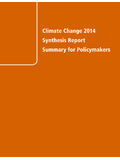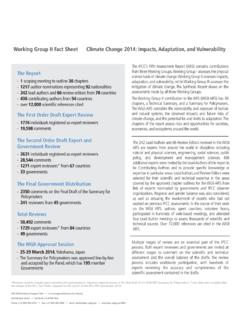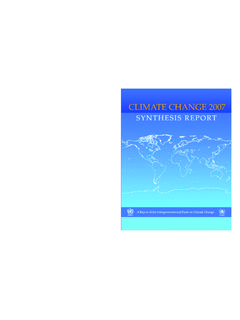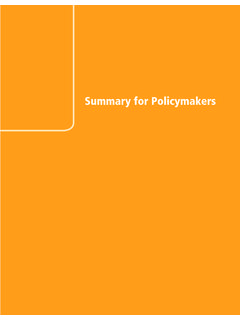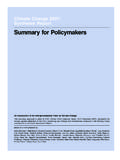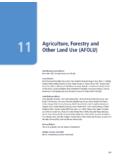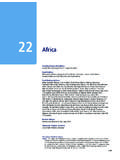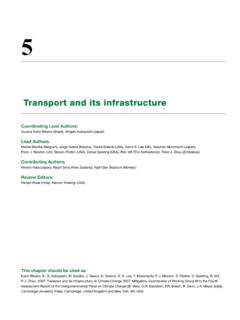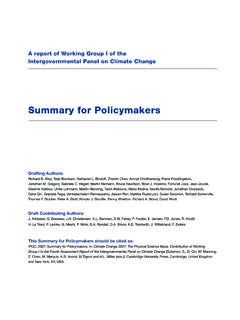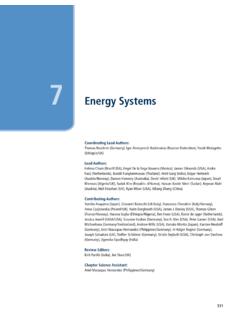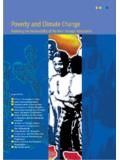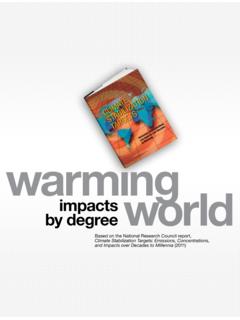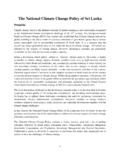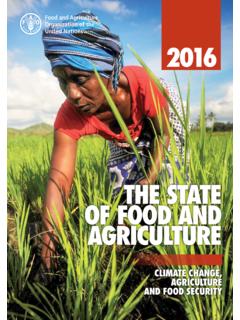Transcription of 19 — Emergent Risks and Key Vulnerabilities - IPCC
1 103919 Emergent Risksand Key VulnerabilitiesCoordinating Lead Authors:Michael Oppenheimer (USA), Maximiliano Campos (Costa Rica), Rachel Warren (UK)Lead Authors:Joern Birkmann (Germany), George Luber (USA), Brian O Neill (USA), Kiyoshi Takahashi(Japan)Contributing Authors:Franz Berkhout (Netherlands), Pauline Dube (Botswana), Wendy Foden (South Africa),Stefan Greiving (Germany), Solomon Hsiang (USA), Matt Johnston (USA), Klaus Keller (USA),Joan Kleypas (USA), Robert Kopp (USA), Rachel Licker (USA), Carlos Peres (UK), Jeff Price(UK), Alan Robock (USA), Wolfram Schlenker (USA), John Richard Stepp (USA), Richard Tol(UK), Detlef van Vuuren (Netherlands)Review Editors:Mike Brklacich (Canada), Sergey Semenov (Russian Federation)Volunteer Chapter Scientists:Rachel Licker (USA), Solomon Hsiang (USA)This chapter should be cited as:Oppenheimer, M.
2 , M. Campos, R. Warren, J. Birkmann, G. Luber, B. O Neill, and K. Takahashi, 2014: Emergent risksand key Vulnerabilities . In: Climate Change 2014: Impacts, Adaptation, and Vulnerability. Part A: Global andSectoral Aspects. Contribution of Working Group II to the Fifth Assessment Report of the IntergovernmentalPanel on Climate Change[Field, , Barros, Dokken, Mach, Mastrandrea, Bilir,M. Chatterjee, Ebi, Estrada, Genova, B. Girma, Kissel, Levy, S. MacCracken, Mastrandrea, and White (eds.)]. Cambridge University Press, Cambridge, United Kingdom andNew York, NY, USA, pp. Summary .. Purpose, Scope, and Structure of this Chapter.
3 1046 Historical Development of this Chapter ..1046 The Special Report on Managing the Risks of Extreme Events and Disasters to Advance Climate Change Adaptation ..1047 Box 19-1. Article 2 of the United Nations Framework Convention on Climate Change ..1047 Box 19-2. Definitions ..1048 New Developments in this Chapter .. Framework for Identifying Key Vulnerabilities , Key Risks , and Emergent Risks ..1050 Risk and Vulnerability ..1050 Criteria for Identifying Key Vulnerabilities and Key Risks ..1050 Criteria for Identifying Key Vulnerabilities .
4 1051 Criteria for Identifying Key Risks ..1051 Criteria for Identifying Emergent Risks ..1052 Identifying Key and Emergent Risks under Alternative Development Pathways ..1052 Assessing Key Vulnerabilities and Emergent Risks .. Emergent Risk: Multiple Interacting Systems and Stresses ..1053 Limitations of Previous Approaches Imply Key Risks Overlooked ..1053 Examples of Emergent Risks ..1053 Emergent Risks Arising from the Effects of Degradation of Ecosystem Services by Climate Change ..1053 Emergent Risk Involving Non-Climate Stressors: The Management of Water, Land, and Energy.
5 1054 Emergent Risks Involving Health Effects ..1056 Spatial Convergence of Multiple Impacts: Areas of Compound Risk .. Emergent Risk: Indirect, Trans-boundary, and Long-Distance Impacts ..1059 Crop Production, Prices, and Risk of Increased Food Insecurity ..1059 Indirect, Trans-boundary, and Long-Distance Impacts of Adaptation ..1060 Risks Associated with Human Migration and Displacement ..1060 Risk of Conflict and Insecurity ..1060 Risks Associated with Species Range Shifts ..1061 Indirect, Trans-boundary, and Long-Distance Impacts of Mitigation Measures.
6 Newly Assessed Risks ..1062 Risks from Large Global Temperature Rise >4 C above Preindustrial Levels ..1062 Risks from Ocean Acidification ..1064 Risks from Carbon Dioxide Health Effects ..1064 Risks from Geoengineering (Solar Radiation Management) ..1065 Table of Contents1041 Emergent Risks and Key Vulnerabilities Chapter Key Vulnerabilities , Key Risks , and Reasons for Concern ..1066 Key Vulnerabilities ..1066 Dynamics of Exposure and Vulnerability.
7 1066 Differential Vulnerability and Exposure ..1066 Trends in Exposure and Vulnerability ..1067 Risk Perception ..1068 Key Risks ..1069 Assessing Key Risks ..1069 The Role of Adaptation and Alternative Development Pathways ..1072 Updating Reasons for Concern ..1073 Variations in Reasons for Concern across Socioeconomic Pathways ..1074 Unique and Threatened Systems ..1075 Extreme Weather Events ..1076 Distribution of Impacts.
8 1077 Global Aggregate Impacts ..1078 Large-Scale Singular Events: Physical, Ecological, and Social System Thresholds and Irreversible Change .. Assessment of Response Strategies to Manage Risks ..1080 Relationship between Adaptation Efforts, Mitigation Efforts, and Residual Impacts ..1080 Limits to Mitigation ..1083 Avoiding Thresholds, Irreversible Change, and Large-Scale Singularities in the Earth System ..1084 Avoiding Tipping Points in Social/Ecological Systems ..1085 Limits to Adaptation ..1085 References ..1085 Frequently Asked Questions : Does science provide an answer to the question of how much warming is unacceptable?
9 1047 : How does climate change interact with and amplify preexisting Risks ? ..1057 : How can climate change impacts on one region cause impacts on other distant areas? ..10621042 Chapter 19 Emergent Risks and Key Vulnerabilities19 Executive SummaryThis chapter assesses climate-related Risks in the context of Article 2 of the United Nations Framework Convention on ClimateChange (UNFCCC). {Box } Such Risks arise from the interaction of the evolving exposure and vulnerability of human, socioeconomic,and biological systems with changing physical characteristics of the climate system.
10 { } Alternative development paths influence risk bychanging the likelihood of climatic events and trends (through their effects on greenhouse gases (GHGs) and other emissions) and by alteringvulnerability and exposure. { , Figure 19-1, Box 19-2}Interactions of climate change impacts on one sector with changes in exposure and vulnerability, as well as adaptation andmitigation actions affecting the same or a different sector are generally not included or well integrated into projections of , their consideration leads to the identification of a variety of Emergent Risks {Box 19-2} that were not previouslyassessed or recognized (high confidence).
